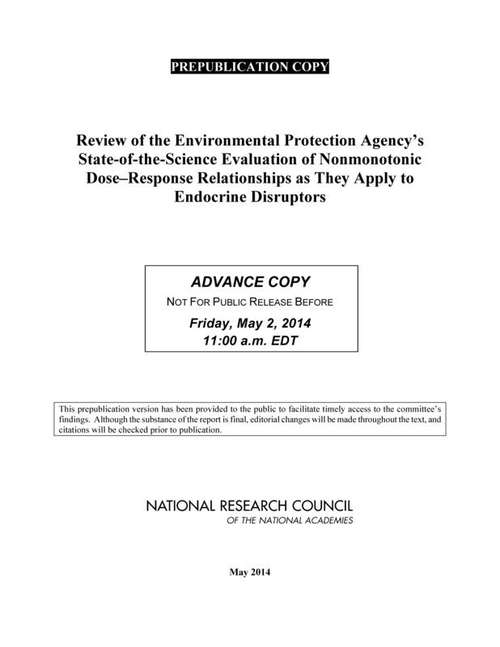Review of the Environmental Protection Agency's State-of-the-Science Evaluation of Nonmonotonic Dose-Response Relationships as they Apply to Endocrine Disruptors
By:
Sign Up Now!
Already a Member? Log In
You must be logged into Bookshare to access this title.
Learn about membership options,
or view our freely available titles.
- Synopsis
-
Potential health effects of chemicals that disrupt endocrine function pose an environmental health concern about their ability to interfere with normal hormone function in human and wildlife populations. The endocrine system regulates biologic processes throughout the body and can be sensitive to small changes in hormone concentrations. Endocrine-disruptor research has focused primarily on chemicals that affect three hormone pathways that play important roles in reproduction and development—the estrogen, androgen, and thyroid hormone pathways. Some of the research has identified dose–response relationships that have nonmonotonic curves. Nonmonotonic dose–response (NMDR) curves are of concern because they do not follow the usual assumption made in toxicology that toxic response decreases as dose decreases. The slope of a NMDR curve changes sign, and the function can take on the shape of a U, the shape of an inverted U, or another shape that has more than one inflection point.
The existence of NMDR curves has been controversial for decades, and there has been considerable debate about their implications for the testing of chemicals and the assessment of risks posed by chemicals. Toxicity tests are designed to identify hazards and to characterize dose–response relationships, so they are aimed at finding a dose that is high enough to elicit a response and exploring dose–response relationships by spacing lower doses to identify a no-observed-adverse-effect level (NOAEL) or a lowest observed-adverse-effect level. One concern raised by NMDR relationships is that such studies as currently designed might not detect critical points (such as peaks and valleys) along a dose–response curve if only a few doses are tested or if the inflection point occurs below the doses tested. Another concern is that some NMDR relationships are found in connection with biologic effects that are not usually evaluated in toxicity tests. If current testing strategies are inadequate to account for NMDR relationships, changes in risk-assessment practices might be necessary.
- Copyright:
- 2014
Book Details
- Book Quality:
- Publisher Quality
- ISBN-13:
- 9780309297547
- Related ISBNs:
- 9780309297554
- Publisher:
- The National Academies Press
- Date of Addition:
- 12/13/18
- Copyrighted By:
- The National Academies Press
- Adult content:
- No
- Language:
- English
- Has Image Descriptions:
- No
- Categories:
- Nonfiction, Medicine
- Submitted By:
- Bookshare Staff
- Usage Restrictions:
- This is a copyrighted book.
